- English
- Esta página
- Página inicial
- Arabic (اللغة العربية)
- Chinese (简体中文)
- French (Français)
- Haitian Creole (Kreyòl Ayisyen)
- Hindi (जानकारी)
- Korean (한국어)
- Polish (język polski)
- Portuguese (Português)
- Russian (Русский)
- Spanish (Español)
- Tagalog (Tagalog)
- Ukrainian (Українська)
- Vietnamese (Tiếng Việt)
- All Languages
Español
PDFs by language
Our 24/7 cancer helpline provides information and answers for people dealing with cancer. We can connect you with trained cancer information specialists who will answer questions about a cancer diagnosis and provide guidance and a compassionate ear.
![]()
Chat live online
Select the Live Chat button at the bottom of the page
Our highly trained specialists are available 24/7 via phone and on weekdays can assist through video calls and online chat. We connect patients, caregivers, and family members with essential services and resources at every step of their cancer journey. Ask us how you can get involved and support the fight against cancer. Some of the topics we can assist with include:
- Referrals to patient-related programs or resources
- Donations, website, or event-related assistance
- Tobacco-related topics
- Volunteer opportunities
- Cancer Information
For medical questions, we encourage you to review our information with your doctor.
Types of Urostomies and Pouching Systems
There are 2 basic options for urostomy surgery, often called urinary diversion. The 2 types are named for how the pathway that allows urine to pass from the body is diverted (re-routed or changed) during the procedure.
- Incontinent diversion, sometimes called a standard or conventional urostomy
- Continent diversion, also called a continent urostomy or continent urinary reservoir
Many factors must be considered when deciding which type is needed. The surgeon will talk with you to help you decide which is the best option.
Incontinent diversion
(standard or conventional urostomy)
Reasons surgery may be needed |
Output |
Management |
Bladder cancer Neurologic dysfunction Birth defects Chronic inflammation of bladder |
Urine and some mucus; will be continuous (non-stop) drainage |
Skin protection is needed; will need a drainable, valve-end pouch that’s adaptable to night drainage |
For this type of urostomy, an ileal conduit is made. An ileal conduit is a small pouch that holds urine. It’s surgically created from a small piece of bowel (intestine).
To make an ileal conduit, a 6- to 8- inch piece of the lower part of the small intestine (called the ileum) is cut out near where it attaches to the large intestine (colon). The rest of the ileum is then re-connected to the large intestine. The ureters are detached from the bladder and attached to the piece of ileum that was removed. The bladder may or may not be removed. The far end of the piece of ileum is brought through the front of the abdomen wall to form the stoma. The other end is sewn closed to make a pocket that holds the urine inside the body. This surgery is a life-long change. The urine output cannot be controlled and a collection pouch will have to be worn at all times.
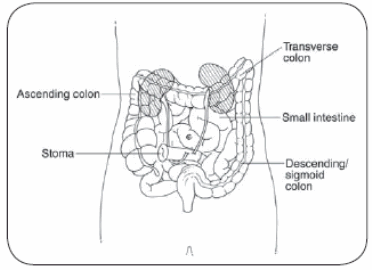
The small intestine produces mucus naturally. The segment of intestine that was used to form the ileal conduit or urine pocket will keep making mucus, too. The mucus will collect in the pouch along with the urine. This is normal.
Continent diversion
(continent urostomy or urinary reservoir)
For this type of urostomy, the surgeon also makes an internal pouch. In this case, the pouch has valves to keep the urine from backing up the ureters into the kidneys. There’s also a valve to keep the urine in the pouch until it’s removed. The pouch must be drained 4 or 5 times a day with a thin, flexible tube called a catheter. The doctor or ostomy nurse will teach you how to drain the pouch and help you make a schedule to do it.
Types of continent diversion urostomies
There are several different ways of creating a continent diversion urostomy, each using different parts to create the storage pouch, valves, and outlet.
Kock pouch: the pouch, valves, and outlet are made from the end of the small intestine (terminal ileum).
Indiana pouch: the pouch is made from the large intestine (ascending colon). The outlet is made from the end of the small intestine (terminal ileum), and the natural ileocecal valve is used.
Mitrofanoff procedure: this type of diversion can have several different variations. The pouch can be made from the bladder, large or small intestines, or a combination. The outlet is made from the appendix, a fallopian tube, or part of the ureter.
Ileal neobladder: the pouch is made from the small intestine (ileum). For a neobladder, there is no ostomy, and urine is passed through the urethra. You won't have the urge to urinate, so a schedule is needed.
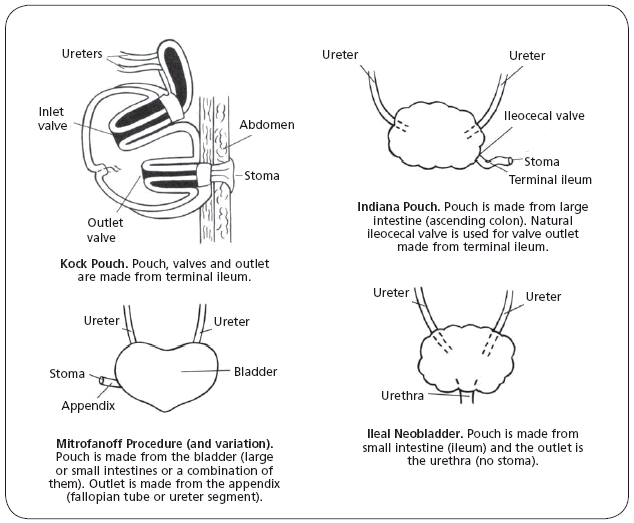
Types of pouching systems
Pouches come in many styles and sizes, and an ostomy nurse can help you choose the best one for your situation and lifestyle. They all have a collection pouch to collect the urinary drainage and an adhesive barrier that sticks to your skin (called a flange, skin barrier, or wafer) and a collection pouch. There are 2 main types of systems available.
- One-piece pouches have both a pouch and skin barrier attached together in the same unit. When the pouch is removed, the barrier also comes off.
- Two-piece systems have a pouch and a separate skin barrier. When the pouch is taken off, the barrier stays in place.
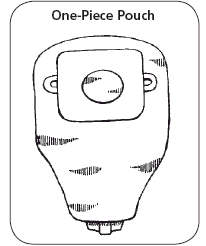
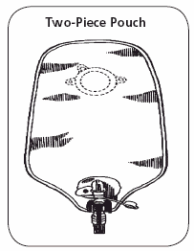
While you are in the hospital after your surgery, an ostomy nurse will talk to you about your personal needs and help you pick a pouching system. For some, this pouch is the type worn for a lifetime. Others will need to change to a new or different type of pouching system later on if they gain weight, grow (in the case of a child), or for other reasons. Do not keep using a recommended pouch if it’s not working the way you need it to. Try different types until you find one that feels good, works well, and is easy to use.
Fitting the skin barrier
The constant flow of urine from the stoma can irritate the nearby skin. The pouching system’s skin barrier is designed to protect the skin from urine and be as gentle to the skin as possible. Depending on the design, you may need to cut a hole out for your stoma, or it may be sized and pre-cut.
Right after surgery the stoma is swollen, but it will shrink over the next 6 to 8 weeks. During this time the stoma should be measured about once a week. A measuring card may be included in boxes of pouches or skin barriers, or you can make your own template that matches your stoma shape. The opening on the skin barrier should be no more than 1/8-inch larger than the stoma size to keep urine off the skin.
Using an ostomy belt or tape
Wearing an ostomy belt to help hold the pouch in place is a personal choice. The belt attaches to the pouching system and wraps around your waist. Some people with urostomies wear a belt because it makes them feel more secure and it supports the pouching system, which can get heavy as it fills with urine. Others find a belt awkward and use tape instead. Tape can be put around the outside edge of the skin barrier like a frame, to help hold it in place.
If you choose to wear an ostomy belt, adjust it so that you can get 2 fingers between the belt and your waist. This helps keep you from getting a deep groove or cut in the skin around the stoma, which can cause serious damage to the stoma and sores (pressure ulcers) on the nearby skin.
If you use an ostomy belt, it shouldn’t ride above or below the level of the belt tabs on the pouching system. People who are in wheelchairs may need special ostomy belts. Supply companies often carry special belts, or an ostomy nurse can talk to you about making one yourself.
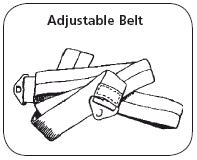
Choosing a pouching system for standard urostomy
You will need a pouching system to collect urine that comes out of the stoma. It must have a barrier that protects the skin around it.
It’s best to talk with an ostomy nurse or someone who has experience in this area when you’re trying out your first pouching system. There should be someone in the hospital who can get you started with equipment and instructions after surgery.
As you’re getting ready to leave the hospital, be sure you get referrals to an ostomy nurse, an ostomy clinic, an ostomy manufacturer, or a chapter of the United Ostomy Associations of America. Even if you must go out of town to get such help, it’s worthwhile, as you want to get a good start and avoid mistakes. Even with help, you may have to try different types or brands of pouching systems to find the one that best suits you.
The size of the stoma, abdominal firmness and shape, the location of the stoma, scars and folds near the stoma, and your height and weight all must be considered. Special changes may have to be made for stomas near the hipbone, waistline, groin, or scars. Some companies have custom-made products to fit unusual situations.
A good pouching system should:
- Stay secure with a good leak-proof seal that lasts for 3 to 7 days
- Be odor-resistant
- Protect the skin around the stoma
- Be nearly invisible under clothing
- Be easy to put on and take off
- Allow you to shower or bathe with the pouch on, if you wish to do so
Factors that can affect the pouching system seal
The pouching system must stick to your skin. It’s important to change it before it loosens or leaks. The length of time the pouch stays sealed to the skin depends on many things, such as proper fitting, the weather, skin condition, scars, weight changes, diet, activity, and the shape of your body near the stoma. Here are some other things that may affect how long a pouch sticks:
- Sweating will shorten the number of days you can wear a pouch. Body heat, added to outside temperature, will cause skin barriers to loosen more quickly than usual.
- Moist, oily skin may reduce wearing time.
- Weight changes will affect how long you can wear a pouch. Weight gained or lost after urostomy surgery can change the shape of your abdomen. You may need an entirely different system.
- Physical activities may affect wearing time. Swimming, very strenuous sports, or anything that makes you sweat may shorten wearing time.
Using a night drainage system
At night the bottom of the pouch can be connected to a night drainage system which carries urine away from the stoma while you sleep. This lets you sleep undisturbed. Gravity drains the urine to a bedside container. This keeps your pouch from getting so full and heavy that it pulls away from your body. It also protects your stoma and skin against the build-up of strong urine.
When connecting the pouch to the bedside drainage bag, leave a small amount of urine in the pouch before attaching the tubing. This keeps you from setting up a vacuum in the system. The bedside container should be vented and the tubing should be secured at the top of the bag or bottle with no more than one inch of it going down into the bag or bottle. If the urine backs up into the tubing it will stop draining. The drainage container can be hung on the side of the bed, or put in another container on the floor. A small wastebasket may be used for this purpose. Clean the tubing and bedside drainage collector every morning. Pour about 2 ounces of a vinegar-and-water solution into the emptied pouch that’s attached to the night drainage system. (Use 1 part of white vinegar to 3 parts of water.) Let it run out of the pouch, through the tubing, and into the collection container. Then pour it out and hang up the night drainage tubing so it can air dry.
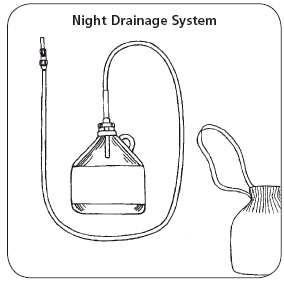
- Written by
- References

The American Cancer Society medical and editorial content team
Our team is made up of doctors and oncology certified nurses with deep knowledge of cancer care as well as journalists, editors, and translators with extensive experience in medical writing.
In its original form this document was written by the United Ostomy Association of America (1962-2019). It has since been modified and updated by the American Cancer Society using the following sources.
Berti-Hearn L, Elliott B. Urostomy care: A guide for home care clinicians. Home Healthcare Now. 2019; 37(5):248-255.
Hollister. Urostomy: What’s right for me. Accessed at https://www.hollister.com/~/media/files/pdfs–for–download/ostomy–educational–booklets/hol_os_urostomy–whats–right_na_907603.pdf on October 2, 2019.
United Ostomy Association of America (UOAA). New ostomy patient guide: Colostomy, ileostomy, urostomy, continent diversion. Accessed at https://www.ostomy.org/wp-content/uploads/2018/05/All-In-One-New-Patient-Guide_2018.pdf on October 2, 2019.
United Ostomy Association of America (UOAA). Urostomy guide. Accessed at https://www.ostomy.org/wp-content/uploads/2018/03/UrostomyGuide.pdf on October 2, 2019.
Last Revised: October 16, 2019
American Cancer Society medical information is copyrighted material. For reprint requests, please see our Content Usage Policy.
American Cancer Society Emails
Sign up to stay up-to-date with news, valuable information, and ways to get involved with the American Cancer Society.


